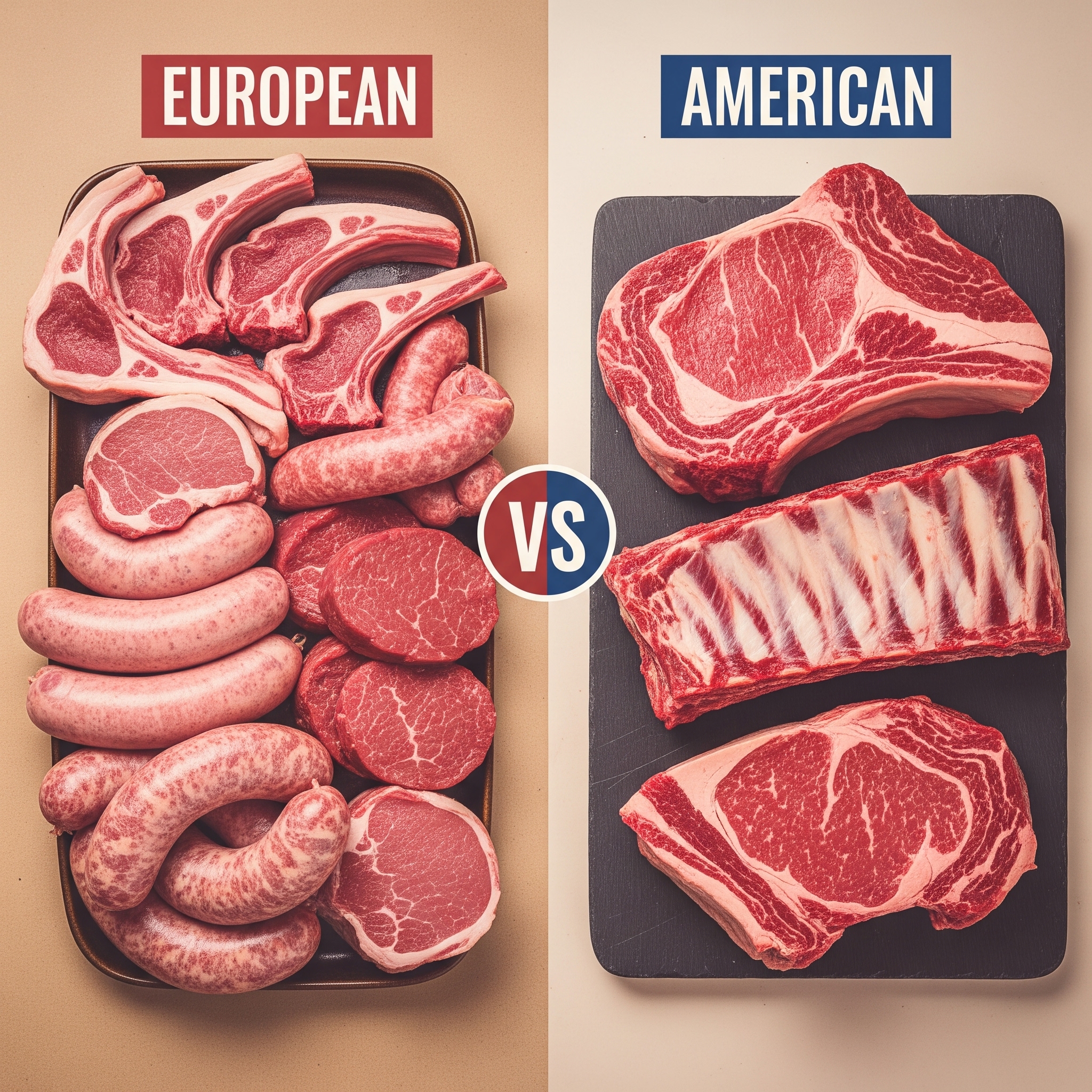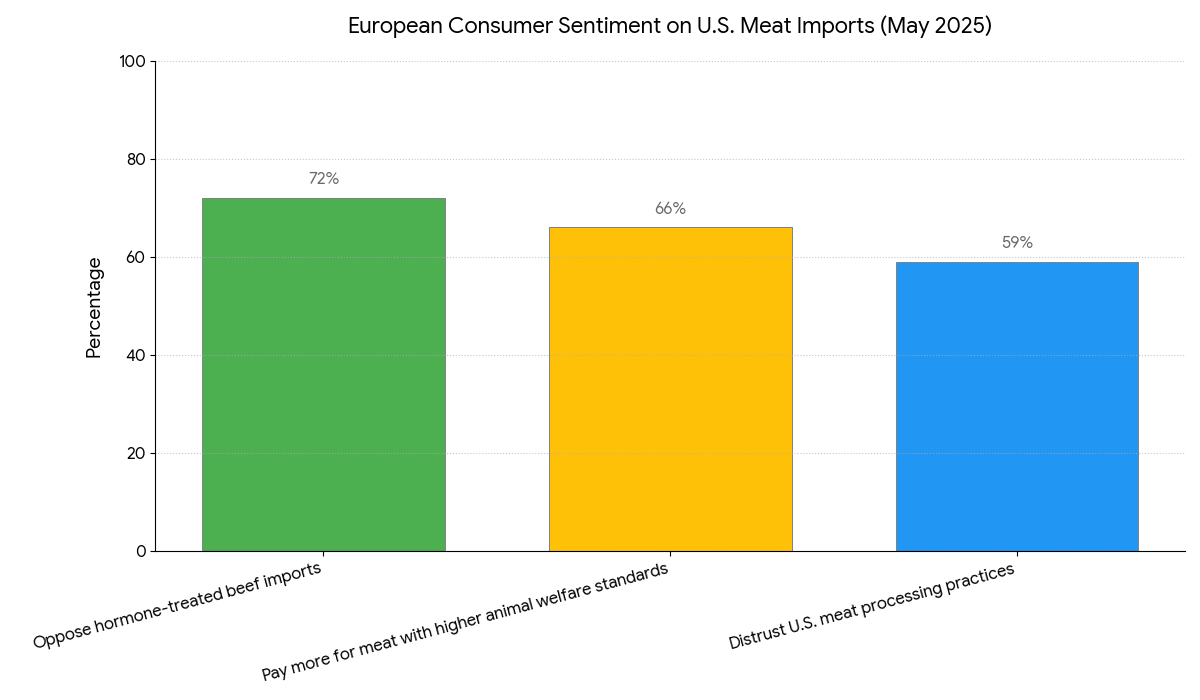
As trade talks intensify between the United States and the European Union, a new friction point has re-emerged: meat. The Trump administration has recently pushed for increased U.S. meat exports to Europe, citing economic opportunity and trade balance. Yet, Europe isn’t biting.
The reason? Hormones, antibiotics, ethics, and a fundamentally different food philosophy. This transatlantic beef (pun intended) isn’t just a diplomatic standoff — it’s a case study in the future of food regulation, public health, and sustainable supply chains.
A Meaty Divide: U.S. vs. E.U. Production Models
At the heart of the controversy is the radically different approach each region takes to meat production.
In the United States, the industrial meat sector is not only massive but strikingly efficient. The U.S. produces about 27 billion pounds of beef annually (USDA, 2024), feeding both domestic and global demand. Much of this is made possible through:
These tools increase animal growth rates, reduce feed time, and lower per-unit cost – all things crucial for profitability in a hyper-competitive, commodity-driven market.
By contrast, the European Union bans all growth hormones in livestock. Since 1989, the EU has strictly prohibited hormone-treated beef, citing health concerns about cancer risks and long-term hormonal imbalances. Additionally, the routine use of antibiotics for growth promotion is also illegal in the EU, aligning with the region’s broader focus on antimicrobial resistance and sustainable farming.
Health Standards vs. Trade Policy
The EU’s stance is not just regulatory, it’s inherently cultural. European consumers consistently prioritize food safety, traceability, and quality over cost. That’s part of why the EU invests more in organically and ethically sourced meat. In 2024, the European organic meat market was valued at €4.9 billion (~$5.3 billion USD), growing at 6.7% annually (Eurostat).
By contrast, the U.S. market is more driven by price and volume. Organic meat in the U.S. makes up only ~2% of total meat sales, according to USDA reports — despite rising consumer interest.
In May 2025, President Trump’s renewed push to get U.S. meat into European markets met heavy opposition. Trade negotiators in Brussels cited not just regulatory issues, but mounting public opposition from consumers. Recent polling by the European Consumer Organization (BEUC) found:

There are several key factors that drive Europe’s resistance to U.S. meat imports:
As mentioned before, the EU bans six growth hormones used in U.S. beef, citing possible links to endocrine disruption and cancer risks, particularly in children. Though U.S. agencies such as the FDA and USDA deem these hormones safe at current levels, the EU’s precautionary principle believes that without conclusive long-term studies, these risks should just be avoided entirely.
In the U.S., over 60% of antibiotics sold are used in livestock, often preventively. This contributes to the global crisis of antimicrobial resistance, which the World Health Organization has labeled a major public health threat. Europe, in contrast, has significantly reduced its veterinary antibiotic use by 43% over the past decade, per EMA reports.
European farms are also often smaller and more regulated when it comes to humane treatment of their livestock. By contrast, U.S. factory farms prioritize scale and efficiency, often at the cost of the animal’s welfare. The EU also has stricter animal housing, transport, and slaughter laws that are non-negotiable for many European regulators and consumers.
This transatlantic impasse has real trade implications. U.S. meat producers view the EU’s $1 trillion food market as a critical opportunity, especially as domestic meat consumption levels off. Yet restrictions mean American producers lose out on millions in export revenue each year.
According to the American Meat Institute:
Even when the EU agreed to increase its quota of U.S. hormone-free beef in a 2019 WTO resolution, volumes remained limited — and only companies that raise cattle without hormones (a tiny minority) could qualify.
This U.S.-EU dispute shines a spotlight on a deeper global shift: consumers want more transparency, traceability, and trust in what they eat.
The shift isn't just philosophical — it's economic:
This creates a massive opportunity for AI-powered supply chain innovation — the very foundation of Journey Foods’ model.
At Journey Foods, we understand that sustainable, ethical, and healthy food is the future — but getting there requires smart, data-driven systems.
Here's how we fit into this global transformation:
Conclusion: Less Hormone, More Harmony
As the U.S. pushes for more meat exports to Europe, the debate over food quality, health, and ethics is only intensifying. But rather than viewing it as a trade war, we should see it as a turning point.
Consumers around the world are demanding more than just low prices — they want quality, integrity, and sustainability. For producers and brands that embrace this shift, there’s not only room to grow but to lead.
The future of meat isn’t just about feeding the world. It’s about feeding it better.
